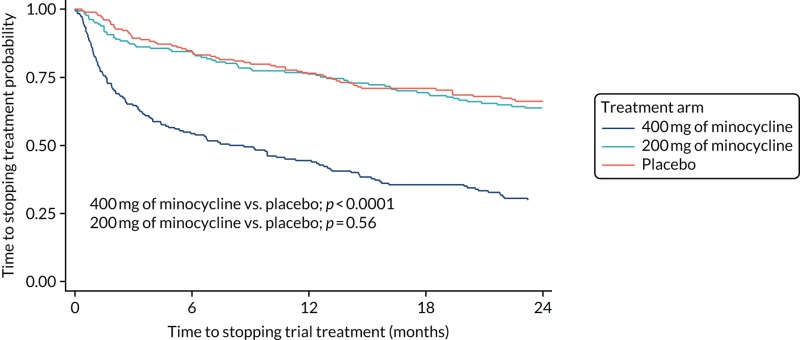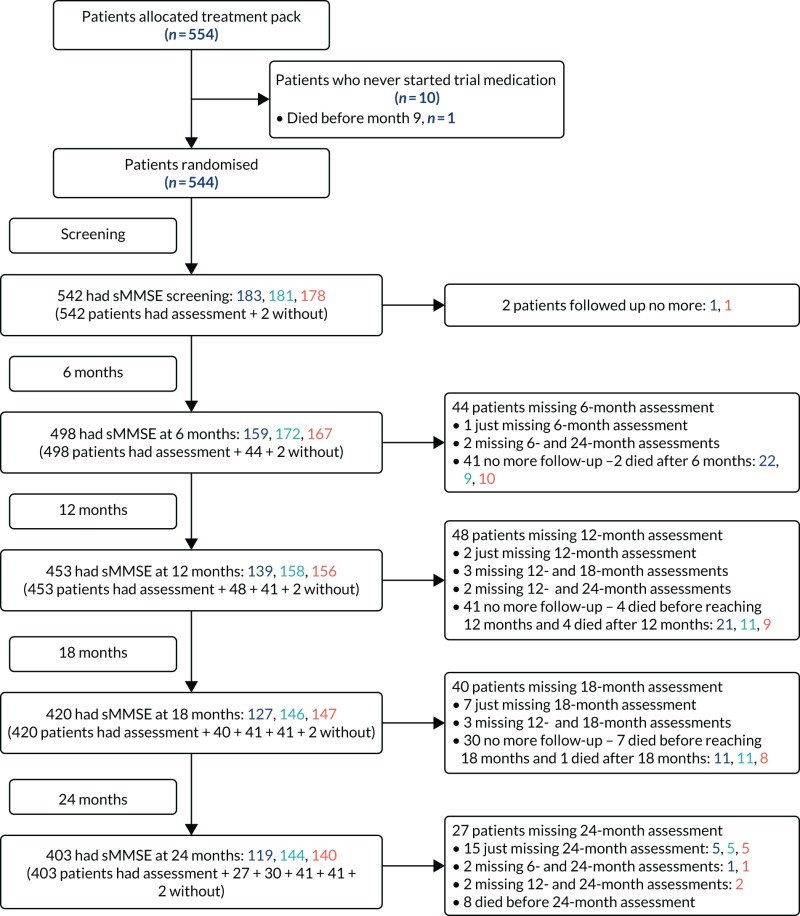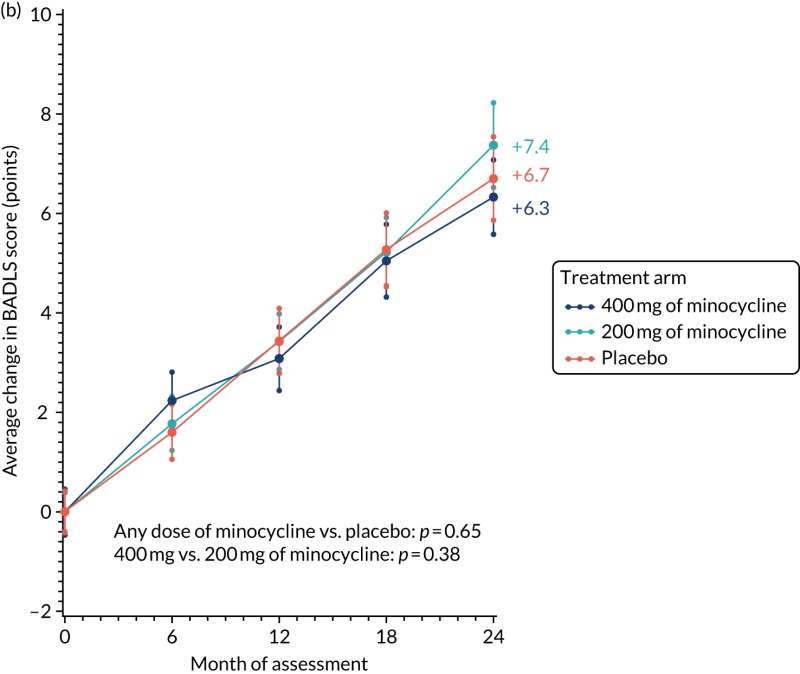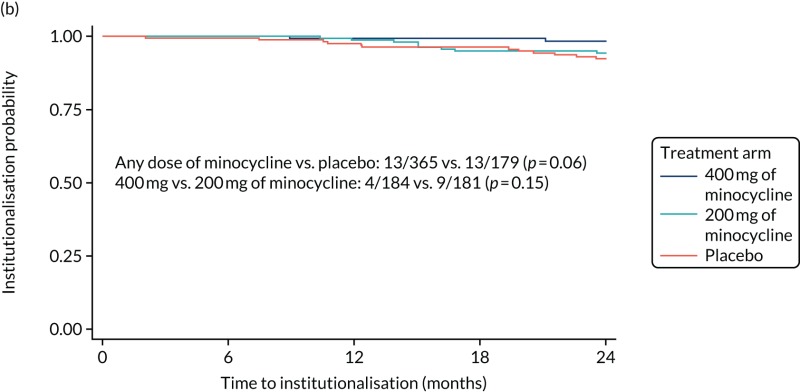| Gastrointestinal |
|---|
| SAE031 | Gastroenteritis | Yes |
| SAE067 | Constipation. Was taken to hospital, patient described medication | Yes |
| SAE064 | Gastroenteritis | Yes |
| SAE077 | Sigmoid volvulus with faecal impaction | Stopped > 28 days ago |
| SAE075 | Diverticulitis and impacted bowel | Yes |
| SAE087 | Deranged LFTs/stomach ulcer with gastrointestinal bleed | Yes (stopped same time) |
| SAE149 | Abdominal distension pain | Stopped > 28 days ago |
| SAE091 | Constipation. Admitted to hospital with sickness/stomach pains | Stopped < 28 days ago |
| SAE095 | Gradual internal bleeding of the stomach lining | Yes |
| SAE092 | Diarrhoea, vomiting and weight loss. Ambulance called and patient was admitted to hospital overnight. Hospital-requested RNI scan | Yes |
| SAE106 | Under investigation – severe diarrhoea. Bowels going into spasms | Yes |
| SAE112 | Patient admitted to hospital with severe abdominal pains | Stopped > 28 days ago |
| SAE120 | Undiagnosed stomach pains. Investigations into possible stomach ulcer or recurrence of bowel cancer | Yes (stopped same time) |
| SAE138 | Diverticulitis | Yes |
| SAE181 | Gastroenteritis | Yes |
| SAE164 | Appendicitis | Yes |
| SAE187 | Death from complications after bowel surgery | Stopped > 28 days ago |
| SAE209 | Secondary, adhesion bowel obstruction – resulted in death | Stopped > 28 days ago |
| SAE194 | Bowel obstruction | Yes |
| SAE182 | Cyst on small intestine updated diagnosis previously bowel obstruction | Yes |
| SAE228 | Obstruction of the common bile duct | Yes |
| Respiratory |
|---|
| SAE001 | Pneumonia | Yes (stopped same time) |
| SAE002 | Wheezing and shortness of breath | Yes (stopped same time) |
| SAE012 | COPD | Yes |
| SAE020 | Pneumonia | Yes |
| SAE018 | Pneumonia – resulted in death | Yes (stopped same time) |
| SAE022 | Suicide attempt and subsequent aspiration pneumonia and pulmonary oedema – resulted in death | Stopped > 28 days ago |
| SAE025 | Community-acquired pneumonia | Yes (stopped same time) |
| SAE048 | Sepsis secondary to community-acquired pneumonia | Yes (stopped same time) |
| SAE043 | Pneumonia | Yes |
| SAE047 | Suspected pneumonia/further investigation | Yes |
| SAE079 | Pneumonia and pleural effusion – resulted in death | Yes |
| SAE085 | Pneumonia | Yes (stopped same time) |
| SAE116 | Died – COPD | Stopped > 28 days ago |
| SAE114 | Pneumonia – died in hospital | Yes (stopped same time) |
| SAE117 | Pneumonia preceded by declining neutrophil count which then rose before ceasing IMP | Yes |
| SAE136 | Community-acquired pneumonia | Yes |
| SAE122 | Pneumonia | Yes |
| SAE156 | Increased shortness of breath | Stopped < 28 days ago |
| SAE163 | Breathlessness and extreme thirst | Yes |
| SAE184 | Pneumonia | Yes |
| SAE200 | COPD | Yes |
| SAE226 | Admitted to hospital after fall and contracted pneumonia while in hospital | Yes |
| SAE266 | Admitted to hospital after fall and contracted pneumonia while in hospital. Had fractured a rib | Yes |
| SAE243 | Pneumonia | Stopped > 28 days ago |
| SAE270 | Pulmonary fibrosis | Yes |
| SAE215 | Pneumonia – resulted in death | Stopped > 28 days ago |
| Mechanical injury |
|---|
| SAE004 | Fall resulting in skull fracture | Yes |
| SAE015 | Fall and closed fracture of rib | Yes (stopped same time) |
| SAE021 | Fall out of bed resulting in head and neck injury | Stopped < 28 days ago |
| SAE034 | Fall sustaining cuts, bruising and reduced mobility | Yes |
| SAE053 | Unwitnessed fall out of bed | Yes |
| SAE068 | Fractured pubic rami from a fall | Yes |
| SAE046 | Fracture of right femur from a fall | Yes (stopped same time) |
| SAE054 | Fractured wrist from a fall | Yes |
| SAE080 | Patient fell and fractured pelvis, related to increased dizziness, less steady on feet since starting MADE trial treatment | Stopped < 28 days ago |
| SAE063 | Possible bruised, cracked or broken ribs following a fall as a result of tripping | Yes |
| SAE073 | Shoulder surgery following fall and dislocation | Yes |
| SAE065 | Fractured right humerus from a fall | Yes |
| SAE093 | Cerebral concussion and cut to head from a fall | Yes |
| SAE124 | Fractured right neck of femur | Yes (stopped same time) |
| SAE155 | Road traffic accident – patient hit by car | Stopped > 28 days ago |
| SAE119 | Fall and admission to hospital overnight | Yes |
| SAE139 | Fractured left femur and underwent left hemiarthroplasty | Yes |
| SAE175 | Fractured ribs from a fall | Yes |
| SAE117 | Broken left hip | Yes |
| SAE196 | Fracture of left neck of femur | Yes |
| SAE199 | Knee replacement operation | Yes |
| SAE222 | Fall | Yes |
| SAE232 | Fracture of metacarpal | Yes |
| SAE235 | Facial injury from a fall | Stopped > 28 days ago |
| SAE237 | Collapse and facial injury and nasal fracture | Yes |
| SAE254 | Fractured hip | Yes |
| SAE255 | Fall causing pubic ramus and wrist fracture | Yes |
| SAE258 | Vertigo/dizziness – leading to head injury from a fall | Stopped > 28 days ago |
| SAE256 | Fracture to middle finger and left hand | Yes |
| SAE263 | Mechanical fall and back pain | Stopped > 28 days ago |
| Endocrine and metabolic |
|---|
| SAE008 | Diabetes mellitus management impairment – resolved | Yes |
| SAE007 | New medical diagnosis of type 2 diabetes mellitus | Yes |
| SAE060 | Low sodium levels | Yes |
| SAE061 | Pituitary adenoma | Stopped > 28 days ago |
| SAE056 | Diabetic ketoacidosis | Stopped > 28 days ago |
| SAE072 | Hypoglycaemia | Stopped > 28 days ago |
| SAE118 | Hypoglycaemia | Yes |
| SAE132 | Syndrome of inappropriate anti-diuretic hormone | Yes |
| SAE135 | Low potassium levels as a result of bowel preparation for CT bowel scan | Yes |
| SAE189 | Admitted to hospital after feeling weak and faint. Diagnosed with low sodium levels | Yes |
| SAE190 | Admitted to hospital following low sodium levels and generally feeling weak | Yes |
| SAE249 | Inflammatory arthropathy – probably due to gout | Yes |
| Cancer |
|---|
| SAE005 | Recurrence of bladder cancer | Yes |
| SAE032 | Tumour on kidney – right kidney/part of liver removed | Yes |
| SAE024 | Colon cancer | Yes |
| SAE040 | Colon cancer (open anterior resection surgery) | Yes |
| SAE066 | Chronic lymphocytic leukaemia | Yes |
| SAE096 | Diagnosis of myeloproliferative neoplasm JAK1 | Yes |
| SAE078 | Working diagnosis – colon cancer. Patient feels well so patient/family do not want further tests | Yes |
| SAE083 | Bowel cancer – resulted in death | Yes |
| SAE011 | Cancer of oesophagus | Stopped > 28 days ago |
| SAE123 | Suspected kidney cancer, diagnosis of left renal tumour | Stopped > 28 days ago |
| SAE229 | Chronic lymphoid leukaemia | Stopped > 28 days ago |
| SAE102 | Recent lung cancer diagnosis. Further investigation of cancer shows it to be terminal with secondary cancers in the liver | Yes |
| SAE109 | Bowen’s disease | Yes |
| SAE183 | MDS | Yes |
| SAE147 | Bowel cancer | Stopped > 28 days ago |
| SAE130 | Probable lung cancer, will not undergo treatment for cancer | Stopped > 28 days ago |
| SAE142 | Patient diagnosed with prostate cancer | Yes |
| SAE161 | Prostate cancer with pelvic metastasis | Yes |
| SAE191 | Colonic primary tumour, with extensive liver metastasis | Stopped < 28 days ago |
| SAE193 | Complex atypical hyperplasia | Yes (stopped same time) |
| SAE206 | Lung tumour and secondary cancers | Yes |
| SAE212 | Appearances consistent with lung malignancy. Given comorbid condition for best supportive/palliative care | Yes |
| SAE217 | Vulvar cancer | Yes |
| SAE238 | Tonsillectomy as a result of cancer | Yes |
| SAE251 | Prostate cancer | Stopped > 28 days ago |
| SAE253 | Basal cell carcinoma | Yes |
| Haematological/thrombosis |
|---|
| SAE038 | Low levels of platelets | Yes (stopped same time) |
| SAE045 | Blood transfusion for suspected bleed, following low levels of haemoglobin | Yes |
| SAE110 | DVT | Yes (stopped same time) |
| SAE129 | Neutropenia | Yes |
| SAE145 | Anaemia | Yes |
| SAE236 | Blood clot | Yes |
| Dermatological |
|---|
| SAE245 | Minocycline type 2 pigmentation on face | Yes |
| Neuropsychiatric |
|---|
| SAE009 | Hospitalisation following seizures | Yes |
| SAE019 | Psychosis secondary to dementia. Also mild UTI | Yes (stopped same time) |
| SAE029 | Admitted to psychiatric unit following relapse in psychotic symptoms with agitation | Stopped > 28 days ago |
| SAE128 | Patient confused, lacked co-ordination and had been experiencing more falls for a few weeks | Yes |
| SAE160 | Hospital admission with severe Alzheimer’s dementia, with significant behavioural disturbance | Stopped > 28 days ago |
| SAE050 | Admission to hospital as a result of loss of consciousness | Yes |
| SAE158 | Death as a result of dementia | Yes |
| SAE016 | Subdural haematoma | Yes (stopped same time) |
| SAE152 | AD/Lewy body disease – resulted in death | Stopped < 28 days ago |
| SAE143 | Stroke | Yes (stopped same time) |
| SAE105 | Probable stroke. Also receiving treatment for chest infection | Yes (stopped same time) |
| SAE055 | Minor stroke | Yes |
| SAE146 | Seizure (known epilepsy), cracked bone in ankle | Yes |
| SAE086 | CVA – resulted in death | Stopped > 28 days ago |
| SAE170 | AD | Yes |
| SAE076 | AD | Yes |
| SAE203 | Minor stroke non-haemorrhagic | Yes |
| SAE069 | Stroke | Yes |
| SAE059 | Left intracranial bleed | Yes (stopped same time) |
| SAE154 | AD | Yes |
| SAE166 | Funny turns followed by suspected TIA. Patient hospitalised | Stopped > 28 days ago |
| SAE150 | Stroke | Yes |
| SAE167 | Bleeding on brain | Yes |
| SAE159 | Mini stroke (TIA) | Yes |
| SAE169 | Suspected stroke/seizure | Yes |
| SAE172 | Stroke – resulted in death | Yes |
| SAE088 | Small left frontal lobe cortical haemorrhage | Yes |
| SAE153 | Subdural haemorrhage/blood clot | Yes |
| SAE121 | Admitted following falls, is due to being discharged home with end-of-life/full-time carers. MRI scanning showed chronic subdural haematoma | Yes (stopped same time) |
| SAE134 | Seizure, no diagnosis given | Stopped < 28 days ago |
| SAE218 | Delirium | Yes (stopped same time) |
| SAE219 | Dementia in AD | Yes |
| SAE198 | Confusion, slurred speech, unsteady on feet. Admitted to hospital | Yes |
| SAE230 | Patient in acute psychiatric ward on section 2 | Yes |
| SAE231 | Suspected stroke. Patient died | Stopped > 28 days ago |
| SAE239 | Possible TIA | Yes |
| SAE247 | Delirium | Yes |
| SAE252 | Progression of AD – resulted in death | Yes (stopped same time) |
| SAE265 | CVA | Yes (stopped same time) |
| Cardio-circulatory |
|---|
| SAE036 | Suspected myocardial infarction | Yes |
| SAE030 | Shortness of breath and suspected MI | Yes |
| SAE010 | Cardiac abnormalities: long QT on ECG and impaired left ventricular function | Yes |
| SAE062 | Cardiac event – resulted in death | Yes (stopped same time) |
| SAE035 | Myocardial infarction | Yes |
| SAE099 | Syncope attributed to GTN spray overdose (accidental) | Yes |
| SAE090 | Swollen ankles, shortness of breath, ambulance called. Admitted to hospital for 11 days. Diagnosis fluid on lungs and heart murmur | Yes |
| SAE104 | Cardiogenic syncope | Yes |
| SAE094 | Collapsed, thought to be as a result of low blood pressure | Yes |
| SAE098 | Postural hypotension | Yes |
| SAE201 | Out-of-hospital ventricular fibrillation arrest as a result of anterior myocardial infarction – resulted in death | Yes (stopped same time) |
| SAE211 | Recurrent gradual-onset syncope, junctional bradycardia on implantable loop recorder | Yes |
| SAE208 | Postural hypotension | Yes |
| SAE039 | Hospitalisation – low blood pressure/pulse rate | Yes |
| SAE157 | Hypotension | Yes |
| SAE125 | Chest pain | Yes |
| SAE049 | Suspected heart attack resulting in death | Yes (stopped same time) |
| SAE137 | Severe mitral valve regurgitation, which resolved on rate-limiting control of AF and LV improvement in function | Yes |
| SAE144 | Currently unknown – heart-related problems | Yes |
| SAE151 | Death from MI | Yes (stopped same time) |
| SAE168 | Death – coronary atherosclerosis hypertension | Yes (stopped same time) |
| SAE171 | Cardiac arrest | Yes |
| SAE207 | Heart problems. Cardiac monitor had revealed that heart had stopped for short time | Yes |
| SAE202 | Heart failure | Stopped < 28 days ago |
| SAE205 | Heart failure | Stopped < 28 days ago |
| SAE176 | Aortic stenosis | Yes |
| SAE103 | Deterioration in cardiac failure plus syncopal episode that led to hospital admission | Yes (stopped same time) |
| SAE224 | Heart failure – resulted in death | Stopped > 28 days ago |
| SAE241 | Heart attack – resulted in death | Stopped > 28 days ago |
| SAE240 | Labile blood pressure/hypertension | Yes |
| SAE246 | Heart failure | Yes |
| SAE248 | Heart attack – resulted in death | Yes (stopped same time) |
| SAE564 | Syncope (probably as a result of bradycardia) | Stopped > 28 days ago |
| SAE268 | Atrial fibrillation | Stopped > 28 days ago |
| Renal |
|---|
| SAE057 | Kidney stones | Yes |
| SAE058 | Large abdominal tumour causing kidney failure – resulted in death | Never started |
| SAE084 | Chronic renal failure – resulted in death | Stopped > 28 days ago |
| SAE101 | No evidence of bladder cancer. Patient was having tests from a bladder biopsy | Yes |
| SAE113 | Radical left nephrectomy laparoscopy | Stopped > 28 days ago |
| SAE204 | Acute kidney injury | Yes |
| SAE267 | Lung and kidney failure – resulted in death | Stopped > 28 days ago |
| Infection |
|---|
| SAE014 | Hospitalisation – chest infection | Yes |
| SAE017 | Hospitalisation – delirium as a result of dehydration and urine infection | Yes |
| SAE044 | Probable UTI, symptoms of confusion, weakness, low mobility | Yes |
| SAE082 | Infection following a foreign body in arm | Yes |
| SAE051 | Chest infection | Yes (stopped same time) |
| SAE052 | Urinary tract infection | Yes (stopped same time) |
| SAE081 | Catheter-associated UTI | Yes (stopped same time) |
| SAE070 | Chest infection | Yes |
| SAE097 | Infection – resulted in death | Stopped > 28 days ago |
| SAE100 | Pruritic rash in the context or urosepsis | Yes |
| SAE107 | Urosepsis | Yes |
| SAE115 | Sepsis, possibly related to gall bladder problems | Stopped > 28 days ago |
| SAE131 | Progressive decline post chest infection | Stopped > 28 days ago |
| SAE127 | Urinary infection | Stopped < 28 days ago |
| SAE141 | Admitted with lower respiratory infection | Yes (stopped same time) |
| SAE165 | Admitted to hospital with very sore throat later diagnosed as thrush | Yes |
| SAE173 | Shortness of breath and chest infection | Yes |
| SAE174 | Shortness of breath and chest infection | Yes |
| SAE180 | Taken to hospital with very low blood pressure and infection | Yes |
| SAE188 | Sepsis | Stopped > 28 days ago |
| SAE195 | On 11 November 2016 wife reports participant has chest infection – resulted in death | Yes (stopped same time) |
| SAE197 | Urinary tract infection | Yes |
| SAE133 | Updated from discharge summary: cellulitis | Stopped > 28 days ago |
| SAE233 | UTI | Stopped > 28 days ago |
| SAE234 | UTI | Stopped > 28 days ago |
| SAE210 | Urinary tract infection, confusion | Yes |
| SAE216 | Oesophageal candidiasis | Yes |
| SAE213 | Admitted with lower respiratory tract infection | Stopped > 28 days ago |
| SAE22 | UTI | Yes |
| SAE223 | UTI | Yes |
| Other |
|---|
| SAE006 | Hospitalisation – collapsed in street | Yes |
| SAE028 | Suspected blood clot in legs. Swollen legs/painful. No blood clot found | Yes |
| SAE033 | Suspected thrombosis – investigations complete no diagnosis of thrombosis. Symptoms of swollen legs have been associated with previously known water condition. Symptoms reduced after treatment | Yes |
| SAE042 | Participant drank white spirit in error | Yes |
| SAE071 | Replacement of left knee | Stopped > 28 days ago |
| SAE111 | Sensitivity and tenderness around left nipple | Yes |
| SAE074 | IMP overdose | Yes |
| SAE089 | Patient collapsed following accidental overdose of ranitidine | Yes (stopped same time) |
| SAE108 | General health decline – resulted in death. Patient was in respite care | Stopped > 28 days ago |
| SAE148 | Osteoarthritis | Yes |
| SAE179 | Jaw, back and neck pain – no diagnosis – cardiac problems ruled out | Stopped > 28 days ago |
| SAE162 | Prolonged hospital stay after planned hernia operation | Yes |
| SAE186 | Admitted for elective abdominal hysterectomy and bilateral salpingo-oophorectomy | Yes |
| SAE178 | No acute medical problem identified. Patient felt as if she had severe indigestion. Investigations into whether or not it was a mild heart attack in A&E (stayed overnight). No explanation found | Stopped > 28 days ago |
| SAE185 | TURP | Yes |
| SAE214 | Hip screw removal | Yes |
| SAE225 | | Yes |
| SAE244 | Postoperative scrotal oedema | Yes |
| SAE242 | Swollen legs | Yes |
| SAE250 | Unknown – resulted in death | > 28 days ago |










